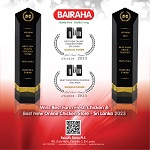Health
The Future of MRI in Nottingham Unveiled
Forty years after taking delivery of the world’s first whole body scanner, and 25 years after the opening of its Magnetic Resonance Centre, The University of Nottingham marks another milestone in its long and distinguished history in the field of MRI (Magnetic Resonance Imaging) research.
Following a £9m investment programme — which includes two new MRI scanners and major upgrades to existing scanners — Nottingham is now equipped with the very latest imaging facilities for innovative research in obesity, gastroenterology, liver disease, metabolism (including sports medicine), orthopaedics, respiratory medicine, mental health, hearing and radiological sciences, as well as new developments in imaging techniques and equipment.
This major initiative brings MRI research facilities on University Park and the Queen’s Medical Centre together under one virtual roof — the newly named Sir Peter Mansfield Imaging Centre (SPMIC). Here’s how the BBC’s Tomorrow’s World programme covered that break through in MRI back in the 1970s.
he establishment of the SPMIC and the 25th anniversary of the Magnetic Resonance Centre’s inauguration is being celebrated today at a one day meeting attended by 200 delegates, including leading experts in biomedical imaging and alumni.
The SPMIC’s new facilities include an experimental upright scanner for the study of gastrointestinal and lung function and joints under weight-bearing conditions; a 3T wide bore whole body scanner for claustrophobic and obese patients; and a mock scanner to improve the MRI experience for younger patients. Major upgrades have also been carried out on the 7T scanner to allow the performance of body, as well as brain, scans. The facilities will exploit the very latest scientific and technical developments in MR and produce a step change in clinical outcomes for patients with innovative and timely studies in experimental and translational medicine.
New SPMIC equipment and enhancements to the infrastructure:
- £1.2m multi transmit upgrade to expand scanning at 7T — the first of its kind to be installed in the UK — from the brain only, to the body.
- A wide-bore 3T MRI scanner for obesity, gastrointestinal and liver research. It will also be used for claustrophobic patients and volunteers participating in non-invasive physiological and musculoskeletal studies.
- A mock scanner and building modifications to provide a child friendly imaging environment, to enhance the experience of scanning, particularly for young children.
- A vertical MR scanner for weight-bearing studies of the musculoskeletal system and for studying the effect of posture on gastrointestinal and lung function. It will also be used by respiratory patients who cannot lie down.
- New equipment for the clinical hyperpolarised gas and dynamic nuclear polarisation (DNP) facilities to increase the sensitivity of MR and develop Nottingham’s strong technical expertise in the study of lung disease and metabolism in muscles and in the brain.
- A significant upgrade to the magnetoencephalography (MEG) facilities to allow real-time data processing. MEG is a non-invasive technique for studying the human brain and brain activity.
- A dedicated electrophysiology laboratory close to the 7T scanner, and a nearby infra-red spectroscopy system for study of the effects of cochlear implantation and hearing loss.
- Optical motion detection cameras for correcting errors produced in images by patient movement during scanning.
- Noise reduction systems to improve patient experience.Extension to the to form new postgraduate student offices and more patient-friendly facilities.
Among many other partnerships and collaborations, the centre will be working closely with NIHR Biomedical Research Units in Gastrointestinal and Liver Diseases and in Hearing, the ARUK Centre for Sport, Exercise and Osteoarthritis with Oxford, the MRC-ARUK Centre for Musculoskeletal Ageing Research with Birmingham, the ARUK National Pain Centre, the Institute of Mental Health and the Respiratory Disease Research Centre.
The story of MRI in Nottingham
It’s a long way from the arrival of that first whole body scanner in 1977 — a machine designed by Sir Peter Mansfield with the help of his team in the School of Physics and Astronomy, built by Oxford Instruments and funded by the Medical Research Council (MRC).
The following year (1978) Sir Peter offered himself as the first whole-body human volunteer. He stepped into the scanner despite warnings that the magnetic gradient was enough to induce cardiac fibrillation. The results proved to be one of the most important breakthroughs in medical science. MRI revolutionised medical imaging and transformed diagnostic medicine.




















































